Google AI Overview is changing the game for search results. This guide breaks down what it is and how it’s different from traditional search and gives you practical strategies to get your content featured in these AI-generated summaries.
Introduction to Google AI and Its Impact on Search
The world of search is undergoing a seismic shift, and Google AI is at the epicenter. This revolutionary technology is transforming how we find information online, making search results more intuitive, accurate, and user-focused than ever before. But what exactly is Google AI, and how is it changing the game for SEO professionals and content creators?
What is Google AI Overview?

Google AI Overview uses artificial intelligence to create comprehensive summaries at the top of search results. Unlike old-school featured snippets that pull from just one source, AI Overview analyzes multiple high-quality sources to build a more complete answer.
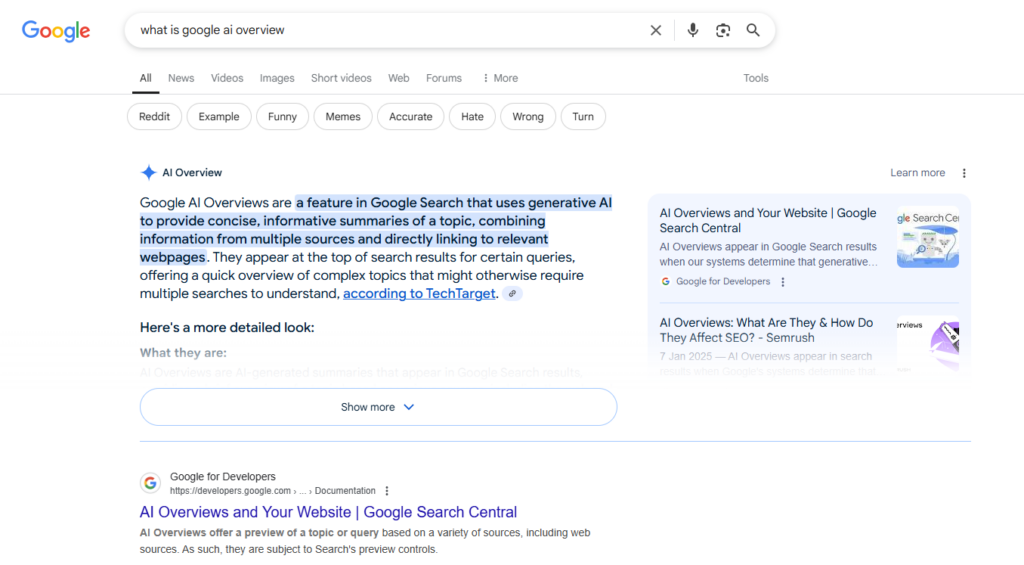
Semrush’s May 2025 study shows these AI Overviews now appear in about 13% of all search results – a big jump since they launched in May 2024. That’s pushing traditional organic listings further down the page, making optimization for AI Overview more crucial than ever.
How Google AI Overview Differs from Traditional Search
Google AI Overview represents a fundamental shift in how search works:
- It combines multiple sources instead of showing individual results
- It prioritizes comprehensive answers over keyword-matched content
- It understands context beyond exact query matching
- It focuses on factual accuracy and authority rather than just relevance
- It prefers well-structured content with clear organization
Surfer SEO’s study of over 405,000 searches found that while 52% of sources in AI Overviews rank in the top 10 organic results, 48% come from lower-ranked pages. This October 2024 research shows AI uses criteria different from traditional rankings, creating new visibility opportunities.
The Difference Between Traditional SEO and AI Overview Optimization
Understanding the distinctions between optimizing for traditional search results versus AI Overviews is crucial for developing an effective strategy:
| Traditional SEO Focus | AI Overview Optimization Focus |
|---|---|
| Keyword density and placement | Comprehensive topic coverage with semantic variations |
| Backlink quantity and quality | Demonstrated expertise and factual accuracy |
| Meta tags and technical elements | Content structure and formatting for AI readability |
| Exact match keywords | Natural language and conversational content |
| Page-level optimization | Topic cluster approach with entity relationships |
How to Optimize Content for Google AI Overview – Research-Backed Strategies

1. Focus on Informational, Long-Tail Queries
SE Ranking’s research shows AI Overviews appear most often for informational queries rather than transactional searches:
- Create in-depth content that tackles specific questions in your industry
- Target longer, more specific search queries that show information-seeking intent
- Develop comprehensive guides that thoroughly answer common questions
As Tom Winter, founder at SEOwind, says, “Google’s AI Overviews have completely changed the game for informational content. The new focus must be creating definitive resources that thoroughly address user questions rather than simply optimizing for keywords.”
2. Implement the CSQAF Framework for Content Development
Several techniques make content more likely to appear in AI-generated outputs. The CSQAF framework organizes these approaches:
- Citations: Include references to authoritative sources and research
- Statistics: Add relevant, current data points with proper attribution
- Quotations: Include expert insights from recognized authorities
- Authoritativeness: Write confidently and show your expertise
- Fluency: Create clear, well-structured content with logical flow
This approach matches what Google’s AI systems look for when generating overviews, boosting your chances of being selected as a source.
3. Optimize Content Structure and Formatting
Advanced Web Ranking’s study of 8,000 keywords found that how you format your content matters. Their March 2024 research shows:
- 78% of AI Overviews contain lists (bullet points or numbered lists)
- Content with clear headings and subheadings appears more frequently
- Short paragraphs (3-4 sentences) beat longer text blocks
- Direct answers placed early in the content have higher inclusion rates
To optimize your content structure:
- Use descriptive H2 and H3 headings that clearly signal what follows
- Break complex topics into scannable sections with logical organization
- Put direct answers to common questions in the first 1-2 paragraphs
- Use bulleted or numbered lists for related points or steps
Tom Winter, founder at SEOwind, notes: “AI is a logic engine, not a search engine. It can only deliver strong content if you feed it real knowledge. Your job is to provide everything it needs to think clearly and stay on track.”
4. Establish Topical Authority Through Comprehensive Coverage
Market Brew’s AI Overviews Visualizer tool indicates that relevance is measured mathematically by comparing query terms to content passages, with higher percentage matches more likely to be included in overviews.
- Create comprehensive content clusters around core topics
- Develop strong internal linking between related content
- Cover all aspects of a topic in appropriate depth
- Include entity relationships that show you understand the subject
- Use semantic variations of key terms throughout your content
“Context is king,” notes Tom Winter, “AI needs fuel, not just prompts. The quality of input directly shapes the output. If you feed it shallow or irrelevant info, it will hallucinate or sound generic.”
5. Incorporate Technical SEO Optimizations for AI
While content quality is key, technical SEO fundamentals remain crucial for AI Overview visibility:
Schema Markup Implementation
Structured data helps Google better understand your content’s context:
- Article schema for blog posts and articles
- FAQPage schema for FAQ sections
- HowTo schema for instructional content
- Product schema for e-commerce content
Indexing and Accessibility
According to Botify and DemandSphere’s 2024 joint research, only indexed content is eligible for inclusion as a cited source in AI Overviews:
- Ensure complete indexing through regular site audits
- Fix crawl errors and optimize crawl budget
- Use XML sitemaps to help Google discover all content
- Implement accessibility best practices for broader content consumption
Page Experience Optimization
Core Web Vitals and user experience signals influence AI Overview inclusion:
- Optimize for a mobile-first experience
- Improve page loading times
- Enhance content readability with proper formatting
- Reduce layout shifts and interactivity delays
Include LLM.txt for AI Crawler Control
In 2024, Google introduced llm.txt, a new protocol that allows site owners to control how their content is used by Large Language Models like those powering AI Overviews.
To optimize responsibly for Google AI:
- Create a llm.txt file at the root of your domain
- Specify which AI agents can or cannot use your content
- Ensure it aligns with your overall content strategy and legal policies
“Think of it as robots.txt for LLMs. It won’t boost your rankings, but it protects your IP while giving you control over AI exposure,” says Tom Winter.

Best practices for optimizing for Google AI Overview Visibility
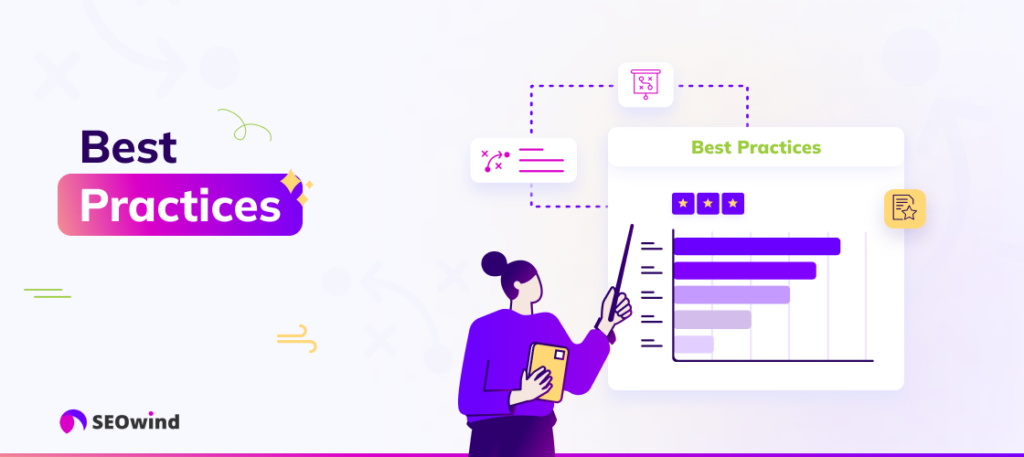
1. Conduct Comprehensive Research
Before creating or optimizing content:
- Analyze which competitors currently appear in AI Overviews for your target topics
- Study the structure, format, and depth of content that consistently appears
- Identify information gaps that your content can uniquely fill
- Gather statistics, expert quotes, and authoritative sources to reference
“Start with research,” advises Tom Winter. “Analyze SERPs, cluster keywords, understand intent, gather stats, and scan Reddit, Quora, and PAA boxes. Use tools and insights to determine what real people ask and how competitors answer.”
2. Create Strategically Structured Content
When developing content:
- Begin with a clear, direct answer to the main query
- Use descriptive H2 and H3 headings that follow logical progression
- Include lists for presenting related points (appearing in 78% of AI Overviews)
- Break text into scannable sections with short paragraphs
- Place the most important information in the first 1-3 paragraphs
3. Demonstrate Expertise and Authority
To enhance E-E-A-T signals (Experience, Expertise, Authoritativeness, Trustworthiness):
- Include author credentials and expertise information
- Reference authoritative sources with proper citations
- Use data and statistics to support key points
- Share firsthand experience and insights when relevant
- Update content regularly to maintain freshness and accuracy
4. Implement Technical Optimizations
Technical aspects remain crucial for AI Overview visibility:
- Ensure proper schema markup implementation
- Optimize page speed and mobile responsiveness
- Create logical internal linking structures between related content
- Make content accessible to both users and search crawlers
- Use descriptive alt text for images
5. Track and Refine Performance
Ongoing optimization should include:
- Monitoring which keywords trigger AI Overviews in your niche
- Analyzing whether your content appears as a source
- Identifying patterns in content that consistently gets featured
- Testing formatting and structure variations to improve performance
- Updating content based on performance data
“Paste your content into ChatGPT and ask why it didn’t make the AI overview,” suggests Tom Winter from SEOwind “It’ll often tell you what’s missing or unclear.”
6. Use Multimedia Elements for a Better User Experience
Google’s AI is becoming increasingly sophisticated in understanding and valuing multimedia content. Incorporating diverse media types enhances user experience and provides Google AI Overview with additional context.
Consider including:
- Images with descriptive alt text
- Infographics to visualize complex data
- Videos to demonstrate processes or explain concepts
- Audio content like podcasts or interviews
By diversifying your content formats, you cater to different learning styles and provide Google’s AI with richer data to analyze and potentially include in AI overviews.
7. Refresh and Update Content Regularly
Google’s AI values fresh, up-to-date content. Regularly updating your existing content keeps it relevant for users and signals to Google that your site is actively maintained and current.
To effectively refresh your content:
- Review and update statistics and data
- Add new insights or information as they become available
- Remove or update outdated information
- Consider republishing with a new date if significant changes are made
Keeping your content fresh increases your chances of being featured in Google AI Overview and maintaining high search rankings.
As we look into optimizing for Google AI Overview, it’s crucial to understand that the SEO landscape is evolving rapidly. Let me present you with the essential strategies for aligning your content with Google’s AI-powered search expectations.
Tools for Tracking Google AI Overview Performance
A significant advancement in 2025 is the availability of specialized tools for monitoring Google AI Overview performance. These tools provide crucial insights beyond what Google Search Console offers:
SEOmonitor
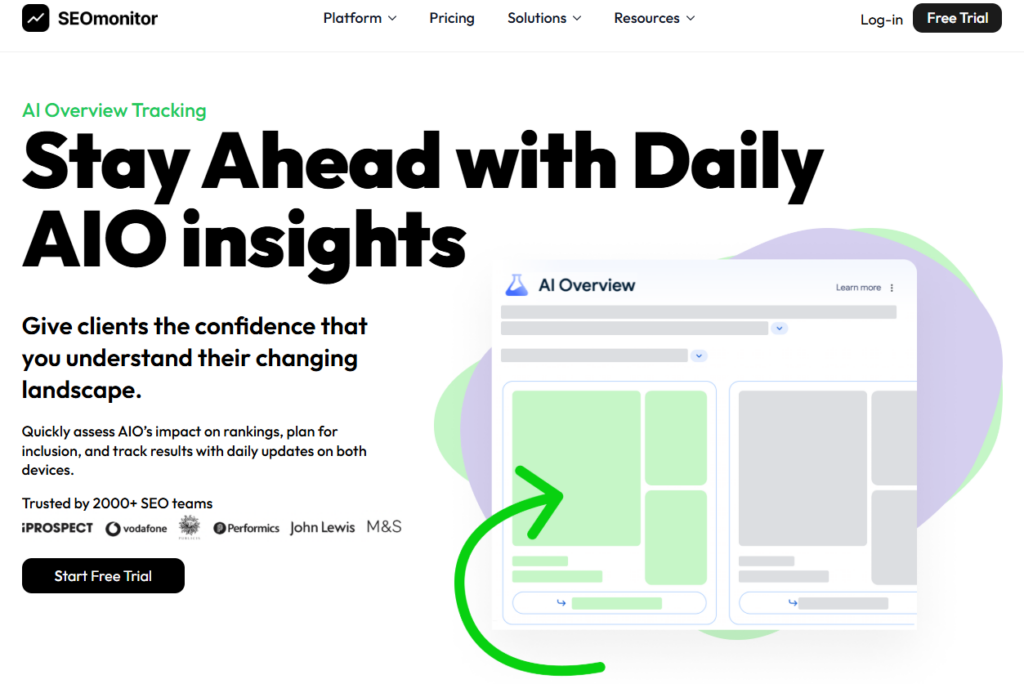
SEOmonitor offers comprehensive AI Overview tracking capabilities, including:
- Daily updates with in-depth insights on the AI Overview performance
- Data export options through CSVs, Google Sheets add-ons, API, or Looker Studio integrations
- Integration with Google Search Console and Analytics to measure impact on organic traffic
ZipTie.dev
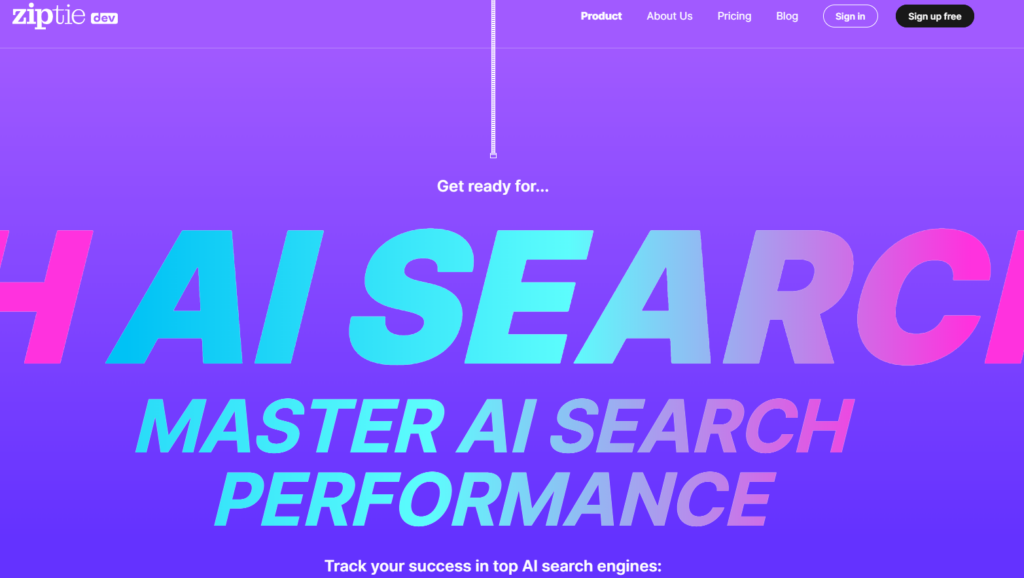
ZipTie.dev specializes in monitoring AI search success across multiple platforms:
- Tracking AI Overviews in 10 countries, including the UK, India, Canada, and Australia
- Comparing your AI search presence with competitors
- Providing an AI success score to help prioritize optimization efforts
- Analyzing AI answers for commercial potential
SE Ranking
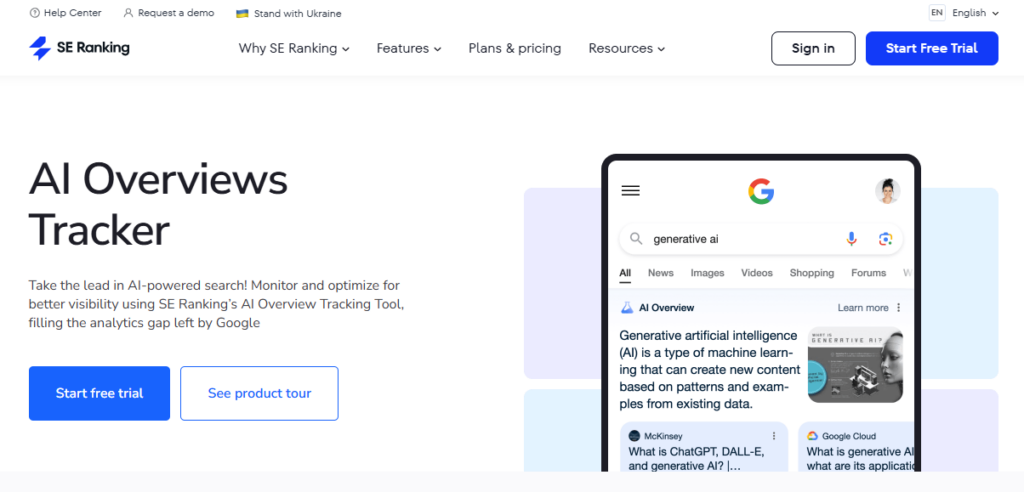
SE Ranking offers robust AI Overview tracking to help you monitor and optimize your visibility in Google’s generative search results:
- Track keywords that trigger AI Overviews, your website’s presence, and ranking positions
- Analyze which domains and URLs appear as sources in AI Overviews, including authority metrics and keyword lists
- Monitor daily changes in your and your competitors’ AI Overview rankings, with filtering options
- Access cached SERPs with AI-generated answers to spot content trends and shifts over time
- Identify search intent and search volume for keywords that trigger AI Overviews
- Compare your AI Overview performance with competitors and export detailed tracking data
Key Metrics to Monitor
When analyzing performance, focus on tracking:
- AI Overview Presence: Which target keywords trigger AI-generated summaries
- Content Inclusion: Whether your website content appears in these Overviews
- Traffic Impact: Changes in organic traffic correlated with the AI Overview’s presence
- Competitor Analysis: How your visibility compares to competitors
- Content Fragment Analysis: Which specific content fragments does Google select from your website
The CyborgMethod™: SEOwind’s Strategy for AI Overview Optimization
The CyborgMethod™ is SEOwind’s proprietary content development framework specifically designed for creating content that performs well in AI-generated search results. This method combines the strengths of artificial intelligence with human expertise to create content that meets both user needs and AI ranking criteria.
The CyborgMethod™ consists of seven key steps:
- AI Research Agent: Uses AI to gather comprehensive topic information
- AI Brief Creation: Develops structured content outlines optimized for AI visibility
- Second AI Research Pass: Validates information and identifies knowledge gaps
- AI Draft Generation: Creates initial content based on research and brief
- Evaluate & Refine Agent: Reviews content for accuracy, comprehensiveness, and optimization
- SEO & Internal Linking: Integrates technical optimization elements
- Human Final Edit: Adds subject matter expertise, tone adjustments, and final polish
This methodology has been developed based on extensive testing and analysis of content performance in Google AI Overviews since their introduction.

AI Overview Impact: Early Results and Observations
While comprehensive case studies with detailed metrics for Google AI Overview optimization are still emerging due to the feature’s recent official launch in May 2024, industry observations reveal significant impacts:
- According to research from RAMPIQ Agency, AI Overviews are pushing traditional search results further down the page, significantly impacting organic traffic patterns
- Google has suggested there may be higher click-through rates (CTR) for links featured in AI Overviews, though the full extent of this impact is still being assessed
- Businesses implementing Google AI optimization strategies are focusing on content restructuring, enhanced E-E-A-T signals, and technical SEO improvements
As noted by Tom Winter “The impact of AI Overviews varies significantly by industry, with YMYL sectors seeing the most dramatic shifts in visibility and traffic patterns. Organizations tracking performance metrics like dwell time are beginning to develop clearer optimization strategies based on actual user behavior with these new search features.”
Generative Engine Optimization (GEO): The Future of SEO
As AI continues to transform search, a new discipline is emerging: Generative Engine Optimization (GEO). While traditional SEO focuses on ranking in conventional search results, GEO specifically targets visibility in AI-generated content like Google AI Overview.
Key Principles of GEO:
- Intent Optimization: Focusing on understanding and addressing the deeper meaning behind user queries rather than just matching keywords
- Semantic Relevance: Creating content that demonstrates understanding of related concepts, terms, and entities within a topic
- Authority Signals: Incorporating clear indicators of expertise through citations, data, and specialist terminology
- Structured Information: Organizing content in ways that make it easy for AI systems to extract and synthesize information
“GEO represents the next evolution in search marketing,” explains Tara Robertson of WSI Digital. “It’s not just about ranking anymore—it’s about becoming an authoritative source that AI systems consistently reference when generating answers.”
FAQ About Google AI Overview Optimization

How can I track if my content appears in Google AI Overviews?
Several specialized tools now offer AI Overview tracking, including SEOmonitor, ZipTie.dev, and Keyword.com’s AI Overview Tracker. These tools monitor which keywords trigger AI Overviews and whether your content appears as a source. Google Search Console doesn’t yet provide specific AI Overview metrics, making these third-party tools valuable for performance tracking.
What content formats perform best in AI Overviews?
Research shows that content with clear structure performs best in AI Overviews. Lists appear in 78% of AI Overviews according to Advanced Web Ranking’s March 2024 study. Content with direct answers early in the text, descriptive headings, short paragraphs, and clear organization has higher inclusion rates in AI-generated summaries.
Does traditional keyword optimization still matter for AI Overviews?
While keywords remain important, AI Overviews prioritize comprehensive topic coverage over keyword density. Focus on semantic variations, related terms, and thorough coverage of subtopics rather than exact keyword matching. The goal is demonstrating complete understanding of a topic rather than optimizing for specific phrases.
How much does traditional ranking influence AI Overview inclusion?
According to Surfer’s October 2024 study of over 405,000 searches, 52% of sources cited in AI Overviews rank in the top 10 organic results, but 48% come from lower positions. This indicates that while ranking helps, content quality and relevance can overcome ranking disadvantages when it comes to AI Overview inclusion.
What industries are seeing the most AI Overviews?
According to NoGood Agency’s August 2024 industry analysis, there’s increased presence of AI Overviews in YMYL (Your Money, Your Life) categories including legal, health, and finance topics. These sensitive areas now feature more AI Overviews likely due to Google’s improvements in quality. Conversely, there’s a notable reduction in AI Overviews for ecommerce and fashion-related queries, suggesting Google prefers to avoid AI summaries for transactional searches.
How often are Google AI Overviews updated?
Google hasn’t publicly specified the update frequency for AI Overviews. However, monitoring from Single Grain’s research team shows they’re regularly refreshed as new content becomes available and as Google’s algorithms evolve. This makes regular content updates important for maintaining visibility in AI Overviews over time.
Will AI Overviews Replace Featured Snippets?
While Google SGE is changing the search landscape, it’s unlikely to completely replace featured snippets in the near future. Instead, we’re seeing traditional featured snippets and AI-generated overviews coexist. The Google SGE rollout is still in its early stages, and the search giant is likely to continue refining how these elements work together.
That said, AI overviews may eventually take precedence over featured snippets for certain types of queries, especially those requiring more nuanced or comprehensive answers. It’s crucial to optimize your content for both traditional featured snippets and AI overviews to ensure maximum visibility.
How Often Do AI Overviews Appear in Google?
The frequency of AI overviews in Google search results is increasing as the Google SGE rollout progresses. However, their appearance varies depending on several factors:
- Query type: Complex queries or those requiring synthesized information are more likely to trigger AI overviews.
- User location: The rollout is happening gradually across different regions.
- User opt-in: Currently, users need to opt-in to see Google SGE results.
As Google continues to refine and expand SGE, we can expect AI overviews to become more prevalent across a broader range of search queries.
How do you get an AI overview on Google?
To see AI overviews on Google, you need to:
- Be in a region where Google SGE is available.
- Opt-in to the Google SGE experience through your Google account settings.
- Perform searches that are likely to trigger AI-generated responses.
What Google SGE shows you might differ from what others see, as the system is still in testing and development.
Can You Opt Out of AI Overviews?
As a user, you can opt out of seeing Google SGE results by adjusting your search settings. However, as a website owner, you cannot directly opt out of having your content used in AI overviews. The best approach is creating high-quality, authoritative content that Google’s AI will likely reference positively.
How should I prepare for AI overviews?
To prepare for AI overviews:
- Focus on comprehensive, in-depth content that covers topics thoroughly.
- Use clear, structured formatting with headings and subheadings.
- Implement schema markup to help Google SGE understand your content better.
- Ensure your website has excellent technical SEO fundamentals.
- Build topical authority by creating clusters of related content.
- Keep your content up-to-date and factually accurate.
How to rank for AI overview?
While you can’t directly “rank” for an AI overview in the traditional sense, you can increase your chances of being referenced:
- Create authoritative, comprehensive content that answers user queries thoroughly.
- Use natural language and a conversational tone in your writing.
- Implement structured data to help Google SGE understand your content’s context.
- Build a strong backlink profile to establish your site’s authority.
- Focus on Expertise, Authoritativeness, Trustworthiness (E-A-T) principles.
- Optimize for featured snippets, as this content is often used in AI overviews.
Remember, optimizing for Google SGE is an ongoing process. Stay informed about the latest developments in the rollout, and be prepared to adapt your strategies as this technology evolves. By focusing on creating high-quality, user-centric content, you’ll be well-positioned to succeed in this new era of AI-driven search.
Key Metrics to Measure Success with Google AI
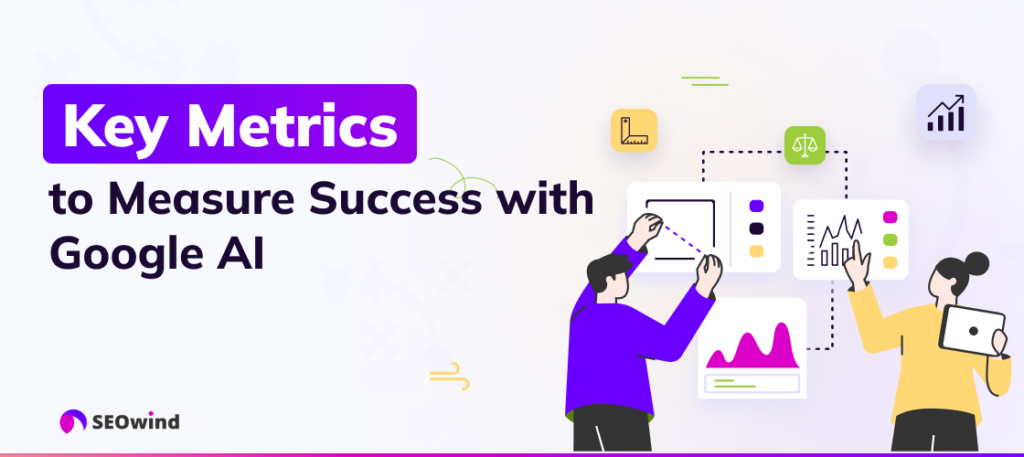
As we navigate the evolving landscape of AI SEO, it’s crucial to adapt our measurement strategies to align with the new realities of Google AI SEO. Traditional metrics are still important, but we need to consider additional factors that reflect the impact of AI on search results. Here are some key metrics to focus on when measuring your success:
- AI-Generated Snippet Appearances: Track how often your content appears in AI-generated snippets or overviews at the top of search results. This metric indicates how well your content aligns with Google AI’s understanding of user intent and topic relevance.
- Click-Through Rate (CTR) from AI Snippets: Measure the CTR specifically for clicks originating from AI-generated snippets. This helps gauge how compelling your content appears when summarized by AI.
- Dwell Time and Bounce Rate: These metrics become even more critical with AI SEO. They indicate whether your content meets user expectations set by AI-generated snippets. Longer dwell times and lower bounce rates suggest that your content satisfies user intent.
- Topic Authority Score: While not an official Google metric, you can create your own by tracking rankings across a cluster of related keywords. This helps measure how well you’re establishing topical authority in the eyes of Google’s AI.
- Featured Snippet Retention: Monitor how long you maintain featured snippets for key queries. Consistent retention indicates strong alignment with Google AI SEO principles.
- Voice Search Performance: As AI increasingly powers voice search, track your content’s performance in voice search results. This can be measured through tools that simulate voice queries.
- User Engagement Metrics: Pay close attention to metrics like comments, shares, and backlinks. These signals help Google’s AI understand the value and relevance of your content.
- Page Experience Signals: With Google’s increasing focus on the user experience, monitor Core Web Vitals and other page experience signals. These factors play a significant role in AI SEO rankings.
- Content Freshness Score: Create a metric that combines factors like publication date, update frequency, and the recency of information in your content. This helps track how “fresh” your content appears to Google’s AI.
- Semantic Search Performance: Track your rankings for semantically related keywords, not just your primary target keywords. This indicates how well Google’s AI understands the context and depth of your content.
- SERP Feature Visibility: Monitor your presence in various SERP features, such as People Also Ask boxes, knowledge panels, and image carousels. These indicate how well Google’s AI interprets and categorizes your content.
- Natural Language Query Performance: Track your rankings for long-tail, conversational queries that mimic natural language. This aligns with the way Google AI interprets search intent.
By focusing on these metrics, you gain a more comprehensive understanding of your performance in light of Google AI SEO’s impact on searching. Regularly analyzing these metrics will help you refine your AI SEO strategy and stay ahead of the competition.
Optimizing for Google AI Overview represents a significant shift in SEO strategy. By focusing on comprehensive topic coverage, structured content formats, demonstrated expertise, and technical excellence, you can position your content to perform well in this new search environment. As AI continues transforming search, these optimization strategies will become increasingly crucial for maintaining visibility and driving organic traffic.


